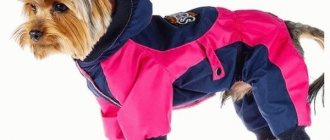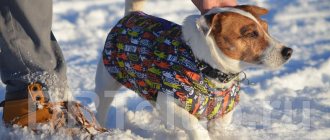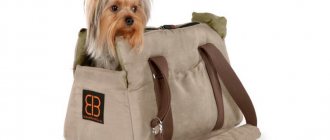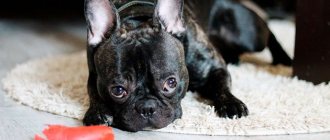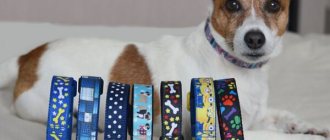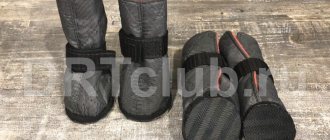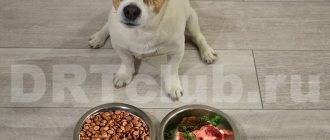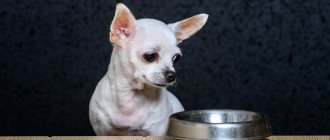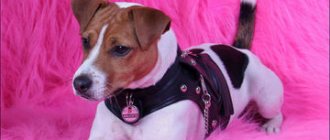As strange as it may sound, pets also need clothes. Today we’ll talk about how a pattern for a dog’s overalls will save the owner from a lot of money. This is especially important for a small dog, since during a walk their paws often get cold, and they often arrive dirty. Today we’ll figure out how to create a pattern with your own hands. Or you can download a ready-made one if you don’t want to bother with the construction.
But before we begin to understand this issue in more detail, let’s consider the main types of overalls:
- Overalls made of waterproof materials. This one is best sewn from bologna fabric. An excellent option for winter overalls, especially for Yorkies;
- Overalls made of light, slippery types of fabric. Perfect for a hike in the forest. Will save your pet from insect bites, and from various plants in the form of burdock;
- Insulated overalls, which use materials such as fleece and padding polyester. Perfect for dogs that have virtually no hair. For example, for the Chinese Crested. For smaller breeds, do not make a heavily insulated version, as it will be very difficult for them to move around in it.
For miniature dogs
Using the pattern we present below, you can sew either a waterproof suit or a summer suit for mini dogs.
Any tailoring begins with creating a pattern. So, let's begin:
- First of all, it is necessary to take measurements from the animal. The first of these will be the length of the back - the distance from the neck to the tail. To make it more convenient to take measurements, it is recommended to put a collar on the dog, then it will be clear and understandable where to start.
- We build a grid for construction. So, the resulting measurement must be divided by 8. The resulting number will be the side of the grid square.
- From the picture below, we transfer the pattern strictly according to the squares.
- Cut it out of paper. We apply it to a piece of fabric and trace as many details as necessary for sewing. We cut the edges strictly along an oblique line. Also, do not forget to leave one centimeter for processing the seams.
- You should get nine parts and a belt, which is necessary for the model with a drawstring. We cut them out.
- Using temporary seams, we sew the parts with the following sides: CO with C1O1, XY with X1Y1, DP with D1P1, E1D1 with E2D2 (start with E1).
- In the same way, we sew the paired parts together with temporary seams.
- We do the first fitting and, if necessary, adjust the product to the animal’s figure.
- If you are making a jumpsuit with a belt, then you need to sew a drawstring to it.
- All temporary seams must be machine stitched. Sleeves and trouser legs too. Next, we insert elastic bands into the legs, just make sure that they do not squeeze the paws too much.
- We process the neck, but the tail part needs to be processed with edging, and only then insert the elastic band.
- Then you need to sew on the flaps to fasten the overalls. For this it is better to buy Velcro fasteners. Unlike other types of fasteners, it ensures a better fit of the product itself on the dog.
The overalls are ready. You can decorate it with pockets or, for example, insert laces so that you can adjust the size of the product. Here it’s up to you to decide what your imagination is enough for. Good luck.
What are corgi clothes for?
Representatives of this breed cannot easily tolerate the effects of low temperatures. Welsh Corgis are prone to kidney disease. This, unfortunately, is a breed problem. Therefore, warm clothes will protect your pet from hypothermia and illness.
In spring and autumn, for walks with your corgi, you need water-repellent overalls, raincoats, and blankets in which the animal’s fur will be protected from rain, slush and dirt.
In the summer, it is recommended to dress your pet so that thorns do not stick to it and ticks do not attack it. It is also necessary for protection from sunlight and overheating.
Shoes are an important item in a Welsh Corgi’s wardrobe, because they protect the pet’s paws:
- from getting wet in wet weather;
- harmful effects of chemical reagents and machine fluids;
- mechanical damage from sticks, thorns, glass, which are often not visible in winter;
- snow sticking between the pads, which causes inconvenience for the pet.
Outfit with a hood
In this section we will look at how to sew a dog costume with a hood. We will sew in the same way as described above. There is only one nuance in which we sew a tailored hood of a comfortable cut to the neck part.
For convenience, it is necessary to make it small.
It is recommended to insert an elastic band so that the hood can be tightened, so it definitely shouldn’t get in the way.
Let's look at the main points when sewing this component of the costume:
- The pattern is presented below. So, cut it out of paper. Apply to the fabric and trace. Cut out all the details;
- We place the visor parts face to face and machine stitch them;
- We turn the product inside out and process the part with an edge-to-edge seam along the curved side;
- Next, you need to sew the resulting visor to the hood itself.
The product is completely ready. Can be sewn to the neck part. As you can see, the visor tends to bend, thereby not interfering with the pet’s looking around. Models of suits with a hood are made mainly for toy terriers or chihuahuas.
Subtleties you should know
During the fitting, when examining the markings on your pet, you must finally make sure where you need to remove it and where you need to make additional fabric inserts. You can always sew (or tie) special tapes (edgings) on the seams afterwards. If there is any material left, you can decorate the product with pockets, and for small breeds, intricate ruffles are suitable. In this outfit, your pet will look very creative.
The bottom of the cuffs on pants and sleeves must be done as carefully as possible. You can make lapels into which you need to insert an elastic band or lace. This will make it easier to adjust the product to size. For decoration, it makes sense to knit ruffles or sew on edgings. In addition, some owners of large, small and medium-sized dogs even decide to knit hats for their pets! The video talks in detail and interestingly about clothing for four-legged animals.
The final touch will be sewing a zipper or Velcro on the back. It is better not to use buttons and ties, as in this case holes are formed through which cold air will penetrate. For convenience and to avoid wool getting into the zipper, you can sew or knit a placket underneath it.
Detailed recommendations can always be found on the Internet.
Back Next
For large pets
Before you start sewing, you need to decide on the fabric.
For large dogs, it is best to use bologna, as it washes well and dries quickly.
Below is a pattern that you can use to sew a costume for your pet. Moreover, you can sew all three types of overalls.
So, first, let's take measurements:
- Measure A - length from neck to tail;
- Measurement B - length from the neck to the hand of the front paw;
- Measure C - length from the neck to the hand of the hind paw;
- Measure D - neck circumference.
This concludes the taking of measurements. The pattern has angles a and b, they need to be made obtuse, this is about 135 degrees, maybe less, but not much. Thanks to them, your pet will be able to move around calmly.
After taking measurements, you need to create a pattern. Then cut it out and trace it onto the fabric. We cut out two identical parts from the material from which you will sew. We sew them together, just remember to leave the paws, neck and tail unsewn. We process all seams with bias tape, if necessary, insert elastic bands.
We also invite you to look at a selection of costume patterns for a girl’s dog and a boy’s (male) dog:
When raincoats are not needed
We can say with confidence that raincoats are not useful for large dogs with short hair. Typically, such animals tolerate cold well and are able to regulate their heat output. For decorative small animals, cloaks are also not always necessary. If your pet has thick fur and feels great even in the cold, you shouldn’t wrap it up.
Important : constantly wearing an oilcloth raincoat can worsen the condition of the coat, especially in short-haired dogs.
Pattern of overalls for a dog
Every owner tries to surround their pet with care and love as much as possible.
During the cold season, dogs need warm clothes just as much as people. The modern market for pet products presents many options of different styles and colors. However, their price is not always acceptable. This does not mean that your pet will freeze. After all, you can sew a jumpsuit yourself, showing a little imagination, as well as mastery of cutting and sewing skills.
Printing out key pattern elements
To complete this point, basic knowledge of office programs is sufficient:
- Download 2 patterns (right-click the bear on the link, select “Save as.”, indicate the path);
- Copy the pattern elements and paste them into the MSExcel document;
- Click on the picture and select “Size and Properties” in the menu that opens;
- Check the box - “scale by width and height” - 100% in the input window;
- Press the “Print” button or the hot keys CTRL+P.
The software will cut and print the template. Take glue, scissors, fold and glue it.
Scheme two:
The best option is below:
Taking measurements
For many breeds, especially decorative ones, overalls are an indispensable part of a walk. It protects against external influences (bright rays of the sun, rain, low temperatures) and insects. When sewing yourself, you should take into account the wearing season. This will help you choose the right fabric. You will also need individual pet sizes.
The first step in sewing overalls is the pattern. To build it you will need to take measurements of your pet. .
- length of the back from the neck to the base of the tail.
- Neck circumference.
- Paw length.
- Hip volume.
- Waist and chest circumference.
This is interesting: Symptoms of Frozen Pregnancy in the Early Stages
Once the necessary parameters are known, you can begin to build the pattern.
How to choose the optimal size
Size gradation:
- The smallest is S. Ideal for animals with a back length of 23-25 cm, a neck volume of 21-23 cm, and a chest of up to 33 cm.
- M: back length 27-29 cm, chest length up to 37, and neck length from 25 to 27 cm.
- Medium breeds are L. Chest circumference is 41-44 cm, neck up to 30 cm, back length no more than 33 cm. Example: raincoat for a miniature pinscher.
- XL: back length 35-37 cm, chest volume up to 48 cm, neck up to 32 cm. These parameters should be taken into account when choosing a raincoat for a cocker spaniel.
- The largest is XXL. The dog's back length should be up to 41 cm, neck up to 36 cm, chest up to 53 cm.
Advice : it is advisable to come to the pet salon with your pet in order to be able to try on the item.
The animal should be comfortable in the protective overalls
Constructing a pattern
The final result of the work will depend on the correct construction of the patterns. Therefore, markings should be approached with maximum care and attention. This will provide a comfortable fit that your dog will appreciate.
There are a large number of options on the Internet suitable for different breeds. The main disadvantage is the lack of all necessary sizes and the individual anatomical build of the animal. Therefore, it is better to build drawings with your own hands.
It is better to make patterns on paper or cardboard. After this, transfer it to the fabric. To develop skills, you can make a trial version in full size . For example, from old bed linen. This will help you get used to it and understand all the intricacies of the work.
Let's consider the option of creating a pattern for small breed dogs.
Step-by-step instruction
- You can start with panties . Here you should take into account the length of the paws and the volume of the hips, since the parts for the front and hind legs will be different. We measure the required number of centimeters and make 2 models each.
- For the body, you need the size from the neck to the base of the ponytail, as well as the volumes of the waist, chest and neck. We apply the required markings on the paper, leaving room for the paws. It is necessary to take into account the activity of each pet. The finished product should be as comfortable as possible and not restrict movement.
- The collar depends on the length of the dog's neck. The length must correspond to the required volumes, and the finished part must be comfortable. You can grab a few extra centimeters so that the collar does not put pressure on the throat and the pet can breathe freely.
- The lower part of the overalls is located on the stomach. For its pattern you will need the dimensions of the distance between the paws. It should be separately noted that the distance between the front and rear legs is different. Therefore, you need to approach the markings with great attention.
Advice . You can make a jumpsuit with an open belly. In this case, you only need the distance between the front legs and the volume of the chest. Such a wardrobe item will cover the back, paws and neck, leaving the tummy.
All parts, except the bottom and collar, are prepared in duplicate, for the right and left sides . After preparing the required models on paper, they are carefully transferred to fabric and cut out. It is better to use chalk for transfer.
Separately, the choice of fabric should be noted. It directly depends on the season of use. For a winter walk, it is better to choose linings made of fur or padding polyester. Patterns are also required to make them. You can use stencils of the overalls themselves.
Important: carefully consider all the features of the body structure, activity and temperament of your pet. A narrow product will hinder movement, press or rub the skin. First of all, the finished overalls should be comfortable.
What will be useful on a walk
In addition to clothing, a collar is required when walking. Many owners think about what is better, a collar or a harness. When choosing between these elements, you should take into account the pet's activity.
The harness can cause bald patches to form, so this item should be avoided during long walks. If the walk is not very long, and the dog is playful and active, then a harness can be safely used.
Important! A collar for puppies and adults must be made of high-quality material. It is best if it is made of leather.
The leash chosen is strong and light.
You can combine free walking with periodic monitoring with a 5-meter leash. It is worth paying attention to tape measures that allow you to quickly reduce or increase the distance.
We take into account the nuances
- In addition to anatomical features, the gender of the animal should also be taken into account . The main difference between overalls for boys is the presence of a special cutout in the genital area. This cutout does not squeeze or rub. It is necessary for comfortable use of the overalls.
Pattern of overalls for a boy
- The choice of fabric depends on the season of use . Polyester is used for the autumn period. It protects well from rain and dirt. Bolognese material can be used for winter. Faux fur, fleece or plush are suitable as insulation.
- For long-haired breeds, it is recommended to use sliding fabric as a lining : satin, silk. Thanks to this, the wool will not roll or tangle. This move will ensure comfortable use of the overalls.
- When sewing winter clothes, sleeves and pants can be equipped with elastic bands . This will ensure that snow does not get under your clothes. The elastic band on the belly ensures a tighter fit to the body. Elastic bands that are pulled too tightly will cause discomfort when walking. Therefore, this detail should be approached very carefully.
- Various components can be used as regulators: buttons, zippers, Velcro, straps . The main thing is that they do not interfere with the pet’s movements. Velcro is not the best option in this situation: they quickly fail due to wool sticking to them.
The main requirement is the absence of discomfort when using the finished product. When sewing, carefully ensure that the overalls do not rub or squeeze the skin, do not interfere with the natural width of the step and do not restrict movement.
Conclusion
Overalls are an important element in a dog's wardrobe. It protects against harmful environmental influences, prevents the penetration of insects and serves as an effective decorative element. Sewing the product yourself will allow you to show maximum imagination and take into account all the features of your pet. This jumpsuit will be truly unique and as comfortable as possible.
Cutting and sewing the entire suit
After a successful fitting, the model is disassembled into stencils, which are used to mark the pattern of the final overalls. Next, everything is exactly the same as with stitching the layout, but with some features:
- When sewing the body and legs, if the dog does not like to dress in different costumes, you should insert an elastic band. It will prevent the animal from taking off the suit ahead of time.
- A zipper is sewn to the top of the suit instead of buttons; it is important not to confuse the back side with the front side and not accidentally sew the zipper upside down. This is a common mistake for beginners.
- The last step is to attach the cervical spine, if required. To do this, you need to sweep 2 halves of the neck of the suit and attach the resulting part with the front side inward, the wide part to the main one, turned inside out, and stitch it. When sewing, do not forget about the hole, which is necessary in order to attach the leash to the collar. It is usually left on the back of the neck.
- If the cervical region is not required, a collar made of fabric tape must be sewn to the same place. He will not allow the dog to take off his overalls.
If the suit requires an insulating lining made of fur, fleece or synthetic padding, this part is sewn according to the same pattern. Only the inner part of the paws should be 2-3 cm longer.
Once everything is stitched, and before you start joining the internal and external parts, it is necessary to carry out a final preliminary fitting, which will allow you to identify any final imperfections.
Once the final check has been completed, you can begin stitching the insulation to the outer part of the suit. To do this, you need to turn the front part inside out, and the insulation with the fur inside. Next, thread the outer part inside the insulated part and stitch around the neck. Sew around the back as well. Turn the resulting structure through one of the trouser legs. Next, the longer legs of the inner layer are folded outward and basted with the outer ones.
The overalls for the dog are ready. Now the pet will be happy and will be able to frolic calmly even in the cold season. But it is important to remember that before dressing your pet for a walk in winter, it is necessary to carry out a preliminary fitting every year. After all, a dog can grow or get better in a year.
Ready-made overalls for dogs: sew them yourself
Loving owners always strive to take maximum care of their pets. This applies not only to health and nutrition, but also to wardrobe themes for any season. It is not necessary to buy your dog ready-made overalls in the store, especially if they are exorbitantly overpriced. You can sew a good and comfortable suit yourself. And you don’t have to be a great sewing master. All you need is to have a pattern and know how to use a thread and a needle.
Some people think that dog clothes are a fashion fad. This statement is not entirely correct. Many dog breeds are not adapted to all weather conditions, and therefore they need additional protection from cold and wind. Basically, this safety measure is required for short-haired and smooth-haired dogs of small and medium sizes. Such dogs without clothes are simply defenseless, and can quickly get sick from the harsh winter climate.
Demi-season overalls protect dogs not only from the cold, but also from dirt, rain or snowfall. A warm suit is very useful for long walks of many hours, and saves your four-legged one from hypothermia.
The advantage of sewing overalls for a dog with your own hands is that you take measurements and sew a model directly to your pet’s parameters. In factory-made products, all measurements are averaged. In addition, with individual tailoring, you yourself choose the material and method of cutting for this clothing.
There are many interesting options on the Internet on how to sew overalls for a dog yourself at home. And if you carefully understand the instructions, then you can do no worse than in a professional studio.
How to measure a dog?
For a raincoat, you need the simplest measurements of your dog:
- Neck volume – measured at the base of the neck; it is more convenient to do this along the line of the collar.
- Chest volume - measured at the widest point of the chest.
- Back length - measured from the base of the neck, more conveniently from the collar, to the root of the tail.
Important! We take all measurements with a small margin, about 0.5 centimeters, without stretching the measuring tape, the animal should be comfortable. If you have a fluffy dog, then we take all measurements without pressing the fur.
Tips for choosing fabric
The choice of material for sewing overalls depends on the time of year and weather conditions of the region. The following requirements apply for a demi-season suit:
- “breathable” fabric so that the dog’s body is sufficiently ventilated;
- high-quality tailoring from durable material so that when touched by branches, the suit does not tear;
- water-repellent (so that the dog does not get wet in case of rain).
The best option for such overalls is membrane fabric. A thin layer of oilcloth is glued to this material, which does not allow the animal to get wet to the last thread . For winter, the overalls should preferably have a lining. When choosing a lining, opt for viscose or twill. It is preferable to sew summer versions of overalls from microfiber or raincoat fabric.
This is interesting: All about cats, cat and spring
Types of clothes for small dogs
Do Dogs Need Clothes: What Breeds Need Clothes?
When choosing everything for your Spitz, you should pay attention to the following clothes:
- a warm down jacket or overalls for the cold season;
- a raincoat made of waterproof fabric or a raincoat for rainy weather;
- a blanket, sweater or sweatshirt will be needed on a dry but cold day, as well as after swimming in a pond;
- a hat to protect the head and ears from hypothermia;
- Shoes and socks will provide protection for your paws.
Little Pomeranians don’t need shorts, T-shirts, dresses and other summer clothes.
Choosing fasteners
The well-chosen method of fastening determines whether putting on the costume will be comfortable for your pet or not. The following can be used as fasteners:
- rivets - they are convenient to fasten on costumes for small dogs;
- Velcro (easy to fasten, but additional fastenings are required);
- laces (used on outfits of small breeds and do not need to be sewn);
- elastic bands (very versatile and can be used for dogs of different sizes and weights).
Manufacturing and joining of main parts
We transfer the pattern to the material. To do this, the fabric must be folded in half with the inside out. Place a sample of the side on top. To avoid distortion of the finished product, it is necessary that the back line runs parallel to the grain of the fabric.
We apply the lower insert with a dotted line along the fold. Templates are pinned or basted. We outline the fixed pattern with chalk, taking into account small allowances (0.5 cm - 1 cm) for the seams. When the pattern is transferred to the fabric, we evaluate it visually and cut it out.
To be sure, it is advisable to initially sweep the product by hand in order to try it on your pet. You need to start sewing from the sides. The legs are sewn together first. The darts on the back are placed in the center, stitched lengthwise and crosswise for strength (dart length 7 cm). Next, we connect the sides by sewing on the lower insert, which covers the stomach and chest.
The prepared parts are sewn down on a machine using a linen stitch (used for sewing bed linen, rompers.).
It is most suitable because:
- Lasting;
- The edges do not require additional processing;
- Eliminates hair tangling.
We take our own measurements for the dog jumpsuit pattern:
Standard jumpsuit pattern
Any master class on sewing clothes for dogs is based on a basic overalls pattern , with no legs.
To create a pattern we need:
- a sheet of paper or a piece of wallpaper;
- ruler;
- a simple pencil;
- fasteners;
- rubber;
- fabric cloth;
- threads with a needle.
Let's start sewing the overalls. First, we measure the pet’s parameters: the length from the neck to the butt and the semicircle of the widest part of the sternum. Afterwards, according to the measured parameters , we draw a rectangle onto the paper.
Visually divide this rectangle into three parts and in the second draw a cutout for the paws. At the same time, we retreat from the transverse lines by about 10 centimeters (based on the size of the dog). Next, draw the neckline and cut out our pattern with scissors.
We apply this template to our fabric, after folding it in half. We trace along the contour and cut the fabric , leaving room for allowances. We mark the seams and do the first fitting, after which it will be clear whether the armholes need to be enlarged or not.
After all the fittings and possible corrections, we sew the connecting parts on a machine. After stitching all the sections, we proceed to sewing Velcro or other types of fasteners. We stretch the elastic bands into the finished armholes and you're done.
Choosing walking shoes
In order for shoes to protect your dog’s paws from harmful chemical and mechanical influences, you need to follow the following recommendations:
Jumpsuit pattern for Yorkie
The peculiarity of the overalls pattern for a breed such as the Yorkshire Terrier is that the details for sewing are very small and require precise calculations. If you cut too little fabric, it will be of no use and will have to be thrown away. It would be wiser to leave a couple of centimeters as a reserve; the excess fabric will be used for turning out the seams.
List of materials that we will need for manual work:
- a sheet of wallpaper or whatman paper;
- a simple pencil;
- ruler;
- sewing material;
- zipper or buttons;
- elastic bands for legs;
- scissors;
- threads with a needle.
First of all, you need to take measurements of your dog , placing it on the table so that it does not spin:
- back length from withers to tail;
- measurements around the neck, chest and waist;
- abdominal measurements (put a centimeter between the front and hind paws);
- sternum width;
- length of all paws;
- head circumference and length of the crown between the ears (if a hood is needed).
It is important that all measurements are as accurate as possible, because only based on them you will understand how loose the suit can be made .
Let's move on to the next step - drawing our pattern. It differs from the basic model only in the presence of pants for overalls.
Step-by-step instruction:
- Divide the previously measured length of the dog's back by the number 8. Transfer the result obtained to a sheet of paper. This will be the side of the cage in centimeters, with which we divide the sheet for the pattern.
- Draw a line equal to half the circumference of the sternum.
- We measure a piece of length and draw a neckline.
- We mark the dimensions of the trouser legs on the drawing. We draw their inner side separately. The length of the pants will be two-thirds the length of the dog's paw.
- We draw curves at the bottom of the trouser legs and at the tail side of the product.
- Now you can cut out the resulting pattern.
Before cutting out the fabric according to the pattern, draw allowances of about 1.5–2 cm. After you have cut out all the details of the overalls, we begin to sew them together by hand using wide stitches. And after preliminary fitting, we grind the edges on a sewing machine. Then we process the seams in any way convenient for you (iron or zigzag). Now you can sew on buttons or a zipper, sew an elastic band on the neckline, and on the cuffs of the panties too. The Yorkie's overalls are ready to use.
For the beauty and style of clothes, you can sew on beautiful fur, pockets or a hood, decorate the product with rhinestones, stripes or bows. By the way, you can make a hood not only for style, but also for protection from rain, wind and other adverse weather .
If your four-legged pet is a boy, then you should make a small notch on the overalls in the belly area so that he can safely go to the toilet. And owners of girls need to know that they should not catch a cold in the stomach. This is especially true for those who feed puppies. The overalls should keep the mammary glands warm, preventing the development of mastitis.
Trying out the layout
Fitting is mainly necessary in order to determine in which areas of the suit adjustments are needed. When sewing, owners often do not take into account such details as the width of the step, the volume of wool and the presence of lining. Because of this, even a suit sewn according to the correct marks can chafe and cause severe discomfort to the pet.
When trying on, the dog must be placed in a standing position. This will allow you to walk around it from all sides and inspect everything more carefully. If the dog is small, then when trying it on, it is better to place it on the table to make it easier to examine.
After checking, if any problems are identified, it is necessary to disassemble the model again and modify its design, and then repeat the entire process with stitching and fitting. If, as a result, the suit layout fits like a glove, then you can start cutting out regular fabric.
DIY overalls pattern for a dachshund
Sewing a jumpsuit for a dachshund is as easy as for any other dog . You just need to take your measurements correctly and select the material for the season. Dachshunds are very energetic dogs, so it is important that clothing does not tighten the pet’s body. But you also can’t make it too big, so that the thing doesn’t hang on the animal like a bag.
The same measurements are taken from the dachshund as when sewing any standard overalls for dogs. The pattern is constructed using the basic method, plus it is supplemented with trouser legs , at the discretion of the owners.
Before you start making a pattern, think carefully about whether you really need a onesie for your dachshund. The paws of a dog of this breed are quite short and it is very difficult to insert them inside the legs. In this case, the most profitable option would be to sew a blanket or vest. The manufacturing technology of these products is very simple.
Some people opt for blankets due to the fact that overalls negatively affect the position of the dog's paws. There is also an opinion that with constant use of overalls on the street, the pet’s body gets used to regular “heating”. As a result of this, he can catch a cold from the slightest room draft . One way or another, if you don’t want to fool yourself with overalls, sewing blankets with your own hands is what you need.
Blanket for dachshund
It's faster and easier to make a pattern from triangles. First of all, measure the length of the dachshund from the neck to the beginning of the tail. Take a sheet of paper and draw a pattern. Mark point X and draw a line from it, a couple of centimeters longer than the length of the pet’s back. We mark point Y on the paper. The resulting segment is the median of our triangle. Having constructed a triangle , we mark a semicircular cut in corner X - this is the place where the dachshund’s tail is inserted. With the help of this hole, the blanket will fit tightly on the pet's body.
We transfer the cut out pattern to the selected material. Among the fabrics for this type of clothing, you should choose thick knitwear. Fabrics such as fleece, felt or cashmere are good for winter and cold autumn. Don't forget to allow seam allowances. When processing the edges we use the method of hemming the seam.
This is interesting: An interesting comedy for the evening
The finished blanket is easy to put on and take off without harming your pet. Having placed the product on the dog’s back, we pull the tail through the hole. We stretch the corners of the blanket over the chest and cross them together. We secure the corners with pins.
Such cozy and easy-to-wear clothes are suitable for cold but dry autumn weather. For rainy and winter weather it is better to use waterproof materials.
Jumpsuit without pattern
For those who do not want to use patterns, there is the option of sewing overalls with your own hands from the sleeve of an old jacket or the jacket itself . For the latest version, you need to cut out a rectangle, the segment of which is equal to the length of the dachshund from the withers to the beginning of the tail.
The width of this rectangle is equal to the size of the dog’s chest circumference with the addition of extra centimeters. Having processed the smaller sides of the rectangle, fasteners are sewn to them, which will be on the back of the animal.
Using chalk, mark the position of the paws and cut out holes for them. These openings are processed with cross stitches (or any other method) or elastic bands are sewn in for a better look of the product.
Reviews
Elizaveta Korovkina, 25 years old, Voronezh.
In winter, I decided to pamper my pet, I went and bought overalls for him at the pet store, at first everything was more or less normal. Later, I began to notice that the dog began to walk somehow strangely. I took a closer look, and in his armpit area everything was red from irritation. As I understand it, the new suit began to rub his skin after some time. I decided to try making the costume myself. I found cutting patterns on the Internet. Everything turned out to be simple, I measured the back, and based on this I sketched out a pattern.
Valeria Aketova, 22 years old, Ekaterinburg.
At the age of 17, my parents gave me a beautiful spaniel, a girl. They called her Curly Lily, because she was all curls like a lamb. Since then I just fell in love with dogs. In addition, my mother is a professional seamstress, and together with her we sewed the first overalls for Curly. It turned out pretty good, especially for the first time. Later, I began to sew costumes on my own, first for myself (my dog), then for my friends. Now I’m doing this professionally, I have a lot of clients, and I make good money from it. And every dog is special, even within the same breed there is practically no dog that is somewhat similar to another. Even in the same brood, even if they have the same appearance at first glance. When trying it on, one dog will definitely trample all over your feet, and the second will not move, like a border guard at a post.
Ekaterina Usoltseva, 19 years old, Rostov-on-Don.
I asked my parents for a dog for a long time, and as a result we went to the shelter and took a small bundle of happiness from there. The color was black, so it was called Night. But that's not what we're talking about. The veterinarian said that for the winter we need a special overall that will protect our dog from the cold, to which she is not adapted. At first, out of ignorance, they took an ordinary suit made of raincoat fabric, but the dog quickly froze in it. Then they tried to buy a suit with insulation. But they couldn’t find the right one, because the mongrel’s structure is different from purebred ones. As a result, they took a suit a little wider, because of which the wind constantly blew through the neck, and such a suit was of no use. When the dog was small, I had to walk it several times a day for 3-5 minutes. After Night got cold once again, it was decided to sew the costume ourselves. We searched for information for a long time, found the most detailed instructions, and started sewing. In the end, everything turned out “so-so.” Only after this did we turn to a professional. The girl came to the house and quickly took all the necessary measurements. A few days later they brought us a ready-made suit, it fits like a glove.
Antonina Kirova, 36 years old, Moscow.
I sewed a raincoat for my Dalmatian Klyaksa, I want to share my experience. The pattern used was similar to the one shown here. As a result, the overalls turned out to be quite pleasant in appearance, and also practical. In order to prevent the dog from getting wet, it was decided to make a suit, which is why it is a raincoat, from raincoat fabric. The suit turned out to be slightly wider than the dog, which is why Klyaksa does not sweat during active walks, and her movements are not at all constrained; there is a Velcro-type tie on the neck, which allows, if necessary, to completely seal the suit. At the same time, elastic bands were attached to the lower parts of the overalls, which can be pulled down to the desired size. Thanks to this, even when jogging through puddles, only the lower parts of the paws remain wet, everything else is reliably protected from moisture and dirt. The zipper was also special, rubberized. It prevents moisture from getting through your back when walking in the rain. In the end, I can say that with minor modifications this pattern deserves high praise. And then, modifications are needed only because this “recipe” is universal. And each season requires its own special operating conditions, which are associated with innovations.
Knitted clothes for Yorkie
For needlewomen who know how and love to knit, you can offer the option of a knitted jumpsuit. It is very popular among owners of small and medium breeds. It doesn't take much time.
Let's consider the process of creating a knitted product for a Yorkshire terrier with the following dimensions: back length - 30 cm, chest circumference - 38 cm. For this knitting you need to purchase 65 grams of wool yarn and two pairs of knitting needles size 4 and 5.
The knitting pattern for a Yorkie suit is as follows:
- We begin to knit the back part of the product, casting on 80 chain stitches on the knitting needles and threading elastic bands for the neck into 10 of these loops.
- We knit the remaining loops first with regular satin stitch, and leave 20 loops for the elastic at the bottom of the overalls. As a result, you need to knit 50 rows.
- We start knitting the belly part, knitting 60 rows of 20 stitches in satin stitch.
- We begin to decrease the row 10 cm from the edge, which is equal to half the columns in the row.
- The loops should decrease symmetrically on both sides.
- We tie the remaining 10 columns with an elastic band for the pet’s neck.
- We sew together both parts of the overalls, leaving openings for the Yorkie's legs.
Stylish and warm knitted clothes for your pet are ready to try on!
Necessary materials
To make the jumpsuit I used the following materials:
- Membrane fabric with water protection.
- Lining fabric on padding polyester (lining stitch). Depending on how warm or not you want the overalls to be, you can use a thinner fabric (for example, flannel, fleece) as the lining layer. If you plan to use the overalls in severe frosts, then as an additional insulating layer you can use Alpolux insulation, which is quite frost-resistant.
- Tractor lightning. If you sew a zipper only along the back (without a collar), as I did, then the length of the zipper must be exactly the same as the length of your pet’s back (in my case it is 30 cm). If you plan to “extend” the zipper to the end of the collar, then its length should accordingly be greater.
Jack always wears collars with us. If I had sewn a zipper along the entire length of the overalls, including the collar, then I would have to put Jack's collar on top of the collar. After all, if I wore the collar down, the leash would constantly rub against the collar, but I don’t think that’s very comfortable. In my opinion, the long lock option is suitable if your pet wears a harness.
What might your mini dog need?
First of all , functional clothing.
In rainy weather - a waterproof raincoat and boots, in the scorching sun - a light T-shirt or dress and a Panama hat, in winter - a warm soft sweater and a hat. These clothes are designed to increase the comfort of walking for your baby and protect his health from hypothermia, sunburn, scratches and dirt, because daily washing is not always good for sensitive dog skin.
Secondly , home clothes. These can be either hygienic panties for girls during heat or soft pajamas, in which your pet will not only look very cute, but will also not freeze, even if there are drafts on the floor.
Third , carnival clothes, in case you decide to take your toy out into the world or just show off to your friends. Here everything is limited only by your imagination, it can be fluffy dresses with frills, office suits with a tie, and any other wardrobe items taken from human clothing and adapted to suit your four-legged friend.
If you can do without carnival and home clothes, then street clothes necessary in our climate . The main thing to remember is that the clothes should be comfortable for your pet.
Important! It is better to choose natural fabric, because synthetics often cause allergic reactions even in humans.
Things should be neither small nor great.
Step-by-step sewing instructions
If we consider the step-by-step instructions with the materials listed above on how to sew a thing, it looks like this:
- Measure the animal’s body and make a pattern for the dog’s overalls according to your own ideas;
Creating a pattern
- Sew the edges of the parts together, insert the elastic into the cuffs with a collar and sew in a zipper;
Ready product
- Decorate the product with various accessories to suit your taste.
As for decoration, you can additionally make a hood. It is not necessary to sew it tightly; you can make it removable. To form a suit, you need to measure the circumference of the head and ears, make a pattern, insert an elastic band into the finished product and sew it to the finished garment. Additionally, you can make a pocket on the side. It is imperative to make a hole for the discharge and cut a hole for the tail, having previously measured the diameter of the corresponding compartment.
You might consider making a onesie with completely closed paws, or come up with detachable shoes with an elastic band, like children's mittens, with a snap or button.
Detachable jumpsuit
The specifics of how a dog's outfit will be created completely depend on the gender of the dog. This is why it is so important to choose the appropriate sewing instructions. The following scheme is suitable for both large four-legged friends and small Spitz or other species. The resulting clothing can be used as a regular raincoat. If you add a comfortable pad to it, your pet will feel comfortable wearing it in winter. All you need is:
- Take measurements, cut the material to start sewing;
- Sew the hood to the back of the throat, additionally inserting an elastic band;
- Place the visor so that it is later convenient for the dog, process it along the curved edge;
- Overlap the straight edge of the visor and sew the visor to the front of the hood;
- Sew up the belly with the side elements of the future product;
- Sew the cuff parts and pull the elastic bands over them.
Attaching to the neck of a stand-up collar
The stand-up collar is cut similar to the placket. This is a rectangle, the width of which is 10 cm, the length is equal to the length of the neckline. The width of the stand will be 4 cm. The inside of the collar is fixed with an adhesive gasket. The piece is folded in half, inside out, and the shorter edges are sewn together. Afterwards, the collar is turned inside out and, making an indentation of 0.5 cm, a line is laid along the seams on the front side. If the volume of the pet's neck is much smaller than the neckline, then you need to make darts or gather the fabric to the required size.
Fold the edge of the armhole and the edge of the collar right sides together and stitch them together. The collar is turned inside out, the seam is secured with an additional stitch and processed with an overlocker. A button/button is sewn on one edge of the collar, and a loop made of elastic or fabric/button is sewn on the other.
Final finishing work
The bottom of the trouser legs is folded inward twice, and an elastic band is inserted into the lapel. If you need to adjust the width of the bottom of the leg according to the situation, you can replace the elastic with a narrow drawstring with a cord or a cuff with a clip. You can also finish the edges with elastic bias tape.
The cutout for the tail is finished with piping and elastic so that the overalls fit the dog's body. A male dog needs one more obligatory hole - for a peephole, so that he can relieve himself normally (cut out and processed in this way).
